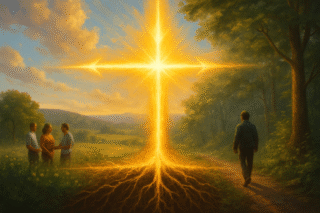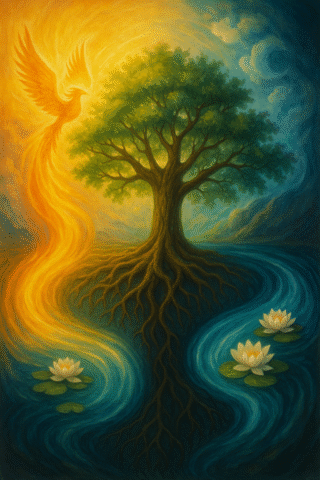GAYNESS AS THE GROUND OF REALITY
What if the love that a gay man feels for another is not only a personal experience, but also a key to understanding the structure of reality itself?
That question has haunted me—in the best way—for many years. My work in queer theology and spirituality begins with a simple proposition: gayness, or more precisely homophilia—the love of sameness—is a metaphor for self-immanence, the inward-facing love of the self for itself. But self-immanence is not a one-size-fits-all idea. Depending on your lens—philosophical, theological, psychological, or contemplative—it reveals itself in diverse and sometimes paradoxical ways.
Let’s take a look at some of those lenses.
Self-Immanence in Integral Philosophy: Holons and the Heart of Reality
Ken Wilber, whose work has greatly influenced my own, teaches that all of reality is composed of holons—entities that are simultaneously wholes and parts. A cell is a whole in itself, and yet it is also part of an organ. A word is a whole, but part of a sentence. A person is a whole self, yet also part of a family, a community, a cosmos.
Each holon, according to Integral Life, has four drives: agency, the drive to assert itself; communion, the drive to connect; self-transcendence, the drive to evolve beyond itself; and self-immanence, the drive to care for, contain, and maintain its constituent parts.
Self-immanence, then, is a kind of inward love. The molecule contains and cares for its atoms. The planet holds its biosphere in balance. The ego shelters the body and the soul. Love moves not just outward, but also inward and downward.
If self-immanence is a fundamental principle of all holons—and if all of reality is made up of holons—then we can say that self-immanence is a universal principle at the very heart of existence. To the extent that gay love mirrors self-immanence, then gayness itself becomes a metaphor for this deepest structure of the cosmos. Homophilia becomes a sacred mirror of the universe loving itself in wholeness.

Self-Immanence in Christian Theology: Agape and the Mystery of the Cross
In Christian thought, God is not only transcendent—utterly beyond creation—but also immanent, present within it. When God loves creation from within, we often speak of this as Agape, or divine, self-giving love.
Jesus himself said, “Greater love has no one than this: to lay down one’s life for one’s friends” (John 15:13). This is not merely a poetic expression; it is the heart of Christian ethics and soteriology. Christ’s crucifixion is understood by many theologians as the supreme act of Agape—God sacrificing God’s own self for the sake of the beloved world.
In this light, gay love can be seen as a mystical participation in that same mystery. Not because gay people must suffer, but because we often do suffer—and in the midst of our suffering, we continue to love. We continue to give. We continue to affirm the other, even when the world tells us we should not exist.
Gayness, understood in this way, is a kind of cruciform love—a love shaped by self-offering and resurrection. It refuses to follow the script of reproductive futurism or normative family roles, not out of defiance, but out of fidelity to something deeper: the recognition that the divine can be found in the face of the beloved. That our love, too, is sacred. That in giving ourselves to one another, we are drawn up into the mystery of death and rebirth, crucifixion and resurrection.
Self-Immanence in Buddhism: Compassion as Emptied Love
In Mahayana Buddhism, the highest expression of spiritual maturity is the Bodhisattva, one who vows to postpone their own final enlightenment until all sentient beings are liberated. At the center of this path is compassion, or karuṇā—the emptying of the self for the sake of others.
This too is a form of self-immanence. Not a narcissistic clinging to the self, but a profound compassion that recognizes the self in others and acts from that recognition. One could say that the Bodhisattva’s love is homophilic—it is love for the other as not-other, as intimately connected and inseparable.
Gay love, in this metaphor, becomes a kind of Bodhisattva vow. It often involves self-sacrifice—not biologically reproducing, not following traditional family lines, sometimes even facing social rejection. But in that refusal of normative reproduction, there is a deeper reproduction of spirit: a way of extending oneself into the world without claiming it for the ego. Gay love can thus become an offering—a form of sacred compassion that gives without grasping.
As the Buddha said: “As a mother would protect her only child with her life, even so let one cultivate a boundless love towards all beings.” (Metta Sutta, Sutta Nipata 1.8). This boundless love is not reserved for parents or saints—it is an invitation to anyone whose heart has been opened by suffering, whose path requires the continual emptying of the self into the love of another. For many of us, this is precisely the shape of our gay love: radical, resonant, compassionate.

Self-Immanence in Psychology: Resonant Love and Intimate Reflection
In secular psychology, we sometimes speak of healthy narcissism: the capacity to love oneself, to see oneself as lovable, to recognize one’s image in another without collapsing into egoism. Gay love, as I see it, often expresses this principle in a uniquely beautiful way.
Another term I use for this kind of gay love is resonant love. It’s not the cliché of “opposites attract”—which, while compelling in certain heterosexual archetypes, doesn’t capture the dynamic energy of same-gender attraction. Resonant love is about similarity, not sameness—a deep recognition of the other as somehow echoing the self. It’s not that the other is you, but that they reflect a frequency of your being that you may not have fully known until you encountered them.
This kind of love is difficult to describe, but myth gives us clues. Think of Gilgamesh and Enkidu, whose bond went beyond friendship, beyond brotherhood—into something mythically charged, something transformative. Or of Castor and Pollux in Greco-Roman myth, twin heroes whose destinies are intertwined. These myths of sexual doubles, heroic comrades, and mirrored souls suggest that this kind of resonant love has long been part of our archetypal imagination.
When I love another man, I’m not simply loving someone “like” me. I’m responding to a vibration—a resonance—that stirs something essential in me. It’s as if the universe tuned two notes to the same pitch, and when they sound together, they amplify each other’s beauty.
This resonance is deeply healing. It allows us to integrate aspects of ourselves that might have been repressed, shamed, or ignored. It draws our attention to the parts of ourselves that crave affirmation, not in isolation, but in sacred recognition. It is a love that brings the scattered pieces of the soul back together, not through opposition, but through mirroring, deep feeling, and profound intimacy.
Resonant love, then, is a psychological and spiritual mystery—a window into the nature of self-immanence as it moves through our emotional and erotic lives. It is not lesser, or derivative, or selfish. It is the echo of the self, calling itself home through the heart of another.
A Practice: Encountering the Divine in Gay Love
Here is a practice for those who want to feel the truth of self-immanence more directly in their own lives:
1. Begin in Stillness
Sit quietly. Breathe. Bring to mind someone of the same gender whom you’ve loved or desired—not necessarily in a romantic way, but in a way that stirred something vital in you.
2. Reflect Deeply
Ask yourself: What part of me did I see in them? What called to me? What essence awakened? Let this question unfold slowly, without rushing to answers.
3. Speak the Sacred
Say inwardly—or aloud if you dare—This love is holy. This yearning is sacred. This person is a mirror of the divine in me. Let the words sink in.
4. Invite the Dialogue
If you have a partner or close friend, invite them into the inquiry. Ask them: What does the divine mean to you? How do you see it in our love? Don’t be afraid of silence. Let mystery be your teacher.
Final Thoughts
There are many other perspectives on gayness and homophilia that I haven’t explored here—anthropological, evolutionary, sociopolitical, and more. Each perspective brings new light. Each one helps us see what has often been hidden.
But the most important thing to understand is this: gayness, to the extent it aligns with self-immanence, is a key to the essence of reality. This isn’t just theory—it’s testimony. It’s embodied. The lives of gay people are a living illustration of this principle. In our desire, in our struggle, in our joy, we enact the universe’s own inward movement: the cosmos loving itself.
To be soulfully gay is to live as that movement. To be the mirror in which the divine sees itself clearly—without shame, without distortion, without apology.
And that is no small thing. That is a revolution of love.




